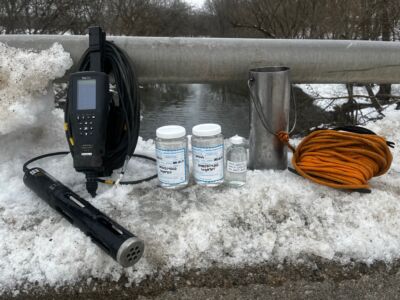PWQMN and Water Quality Targets Monitoring
To collect long-term water quality data at monitoring stations throughout the watershed, the Upper Thames River Conservation Authority (UTRCA) has partnered with the Ministry of Environment, Conservation, and Parks (MECP) in the Provincial Water Quality Monitoring Network (PWQMN) program.
In the watershed, there are 24 active water quality stations that are sampled from March through October or April through November depending on spring melt. Nine of the stations are sampled eight times a year and the other 15 are sampled four times a year.
PWQMN is an example of a successful long-term monitoring program as some of these stations have been continuously sampled since the 1960s when the program was initiated.
Over the years, site locations have been added, removed (due to lack of funding), and relocated near outlets of Upper Thames River subwatersheds to better reflect the UTRCA’s approach to monitoring, reporting, and program implementation. In recent years, winter samples have been collected at five sites once a month from December though March.
In addition to PWQMN, the UTRCA collects additional samples as part of the Environmental Targets: Strategic Plan June 2016 (referred to as Targets Monitoring). Water quality sampling is one way to monitor progress toward achieving Target 1 of the UTRCA’s strategic plan: Improve each subwatershed’s water quality score by one grade, as measured by the Upper Thames River Watershed Report Cards, by the year 2037.
Additional UTRCA-led water quality monitoring includes:
- Sampling the 15 PWQMN stations that are only sampled four times a year to ensure a complete eight-month dataset;
- Sampling three additional long-term stations, so all 28 subwatersheds are sampled for eight months; and
- Sampling for bacteria at all 28 stations after bacteria was dropped from PWQMN.
Targets Monitoring enhances the Watershed Report Cards by ensuring consistency in the samples and data collected from each of the subwatersheds. Water quality data from winter samples are not included in the Watershed Report Cards in order to ensure comparable information and time frames for all subwatersheds. Report cards are produced every five years beginning in 2001.
Data collected from the PWQMN and Targets Monitoring programs is among the most robust long-term datasets at the UTRCA. Data from these programs are used by staff, partners, researchers, and students.
In 2022, the MECP published a paper analyzing Chloride trends in Ontario surface and groundwater using data from three UTRCA PWQMN stations in addition to others in Ontario. The report found that chloride (Cl-) concentrations are increasing (historically below Canadian Water Quality Guidelines and are now meeting or exceeding these guidelines), and winter applications of road salt are a primary contributor to elevated Cl- concentrations.
These trends may be intensified with urbanization and population growth, specifically in southern Ontario.

Contacts: Kaela Orton, Monitoring Technician and Craig Irwin, Water Quality Specialist

